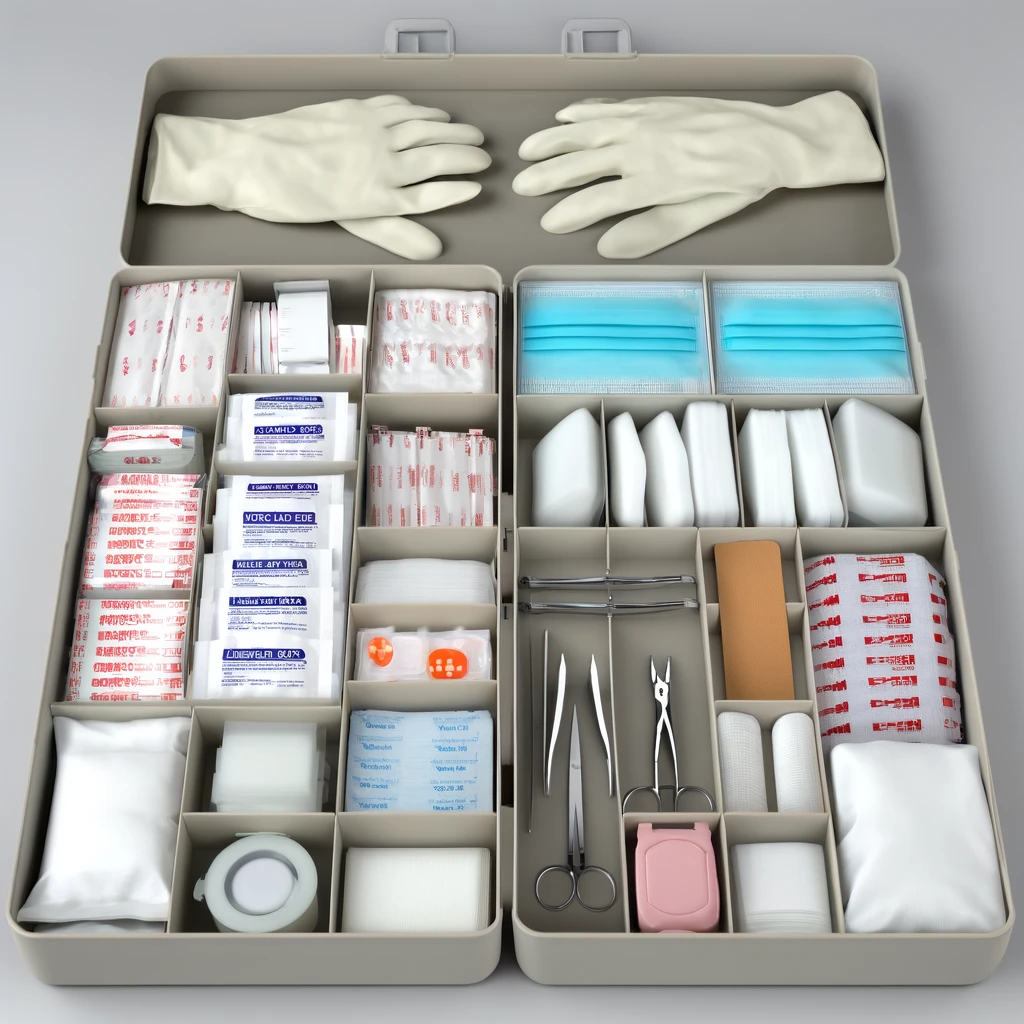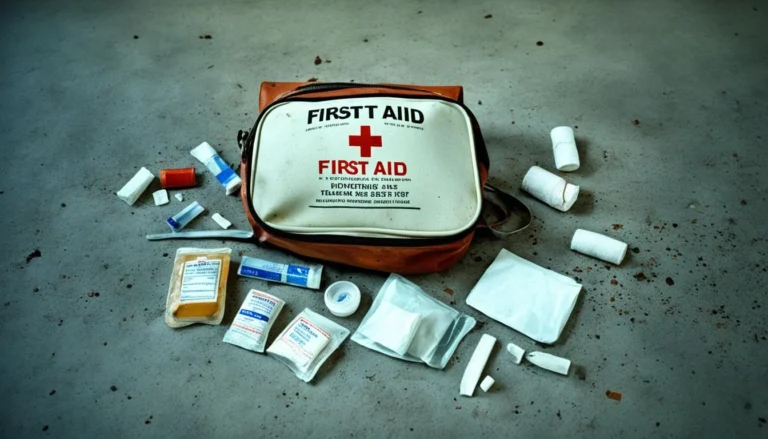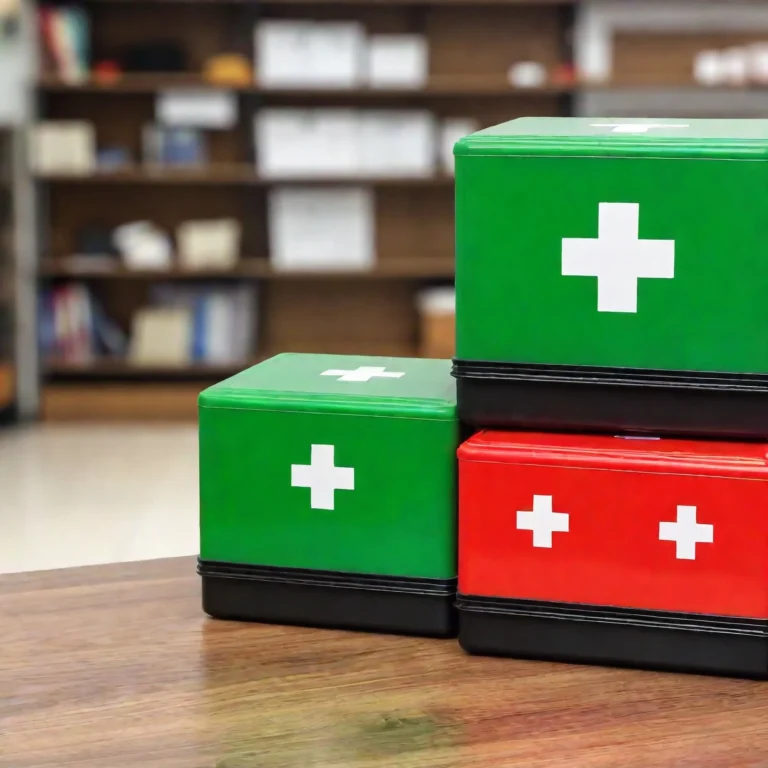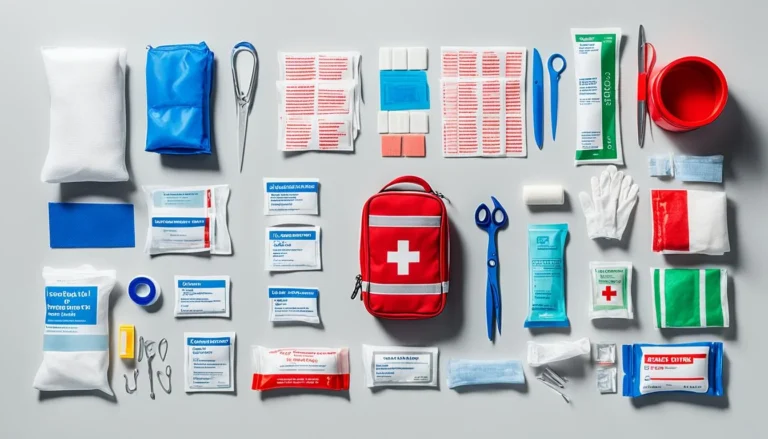Essential First Aid Kit Contents List | Stay Prepared
When an emergency happens, having the right first aid supplies is crucial. If you’re at home or traveling, it’s key to have your first aid kit ready. It should have everything to take care of small injuries and accidents. Make sure to check your kit often. This makes sure it’s complete and easy to get when you need it. In this guide, we will show you what to always have ready for any surprise.
Key Takeaways:
- Ensure a comprehensive list of first aid kit contents for immediate response in an emergency situation.
- Maintain preparedness with a well-organised and stocked first aid kit.
- Prioritize the inclusion of essential supplies to handle a variety of minor injuries.
- Adopt regular checks and updates to your first aid supplies to keep them effective.
- Understand the importance of proper storage to safeguard your first aid kit’s integrity.
Understanding the Importance of a Well-Stocked First Aid Kit
In case of an accident or sudden injury, a well-stocked first aid kit is vital. It’s important everywhere, like in a home or car. Being ready for emergencies means being safe. It’s key to keep the kit’s contents well-stocked and secure.
A good first aid kit is quick help and reassurance. It means small problems can be fixed before a doctor is needed. Checking and refilling your kit ensures it works when needed. Let’s look at what should be in your kit:
- Adhesive bandages of various sizes for minor cuts and abrasions
- Sterile gauze pads to address larger wounds requiring more absorption
- Medical tape to secure gauze or dressings in place without causing irritation
- Disposable gloves to maintain hygiene and prevent contamination risks
- Antiseptic wipes and creams to cleanse wounds and help prevent infection
- A pair of scissors and tweezers for cutting materials or removing debris
- Inelastic bandages for support in the case of sprains or strains
Remember, keeping your first aid kit safe is as important as filling it. Always store it in a reachable, secure spot away from extreme conditions or unauthorized access.
Think about where you might need a first aid kit. You might want different things in it for your home, the outdoors, or your car. Life is full of surprises. Being prepared means acting quickly if there’s an accident or injury. Having a first aid kit is not just careful planning; it’s our duty.
Key Components of a Basic First Aid Kit
A basic first aid kit is for minor mishaps. It should be ready for any unexpected situation. It must have items for different wound care needs.
Various Sized Plasters and Sterile Bandages
Hypoallergenic plasters come in many sizes. They help protect and heal wounds big and small. Along with sterile bandages, they stop bleeding and keep germs out. This starts the healing right.
Gauze Dressings and Eye Pads
Gauze dressings cover big wounds. They soak up blood and keep the wound clean. You must also have sterile eye dressings for eye injuries. They help the eyes heal faster.
Tweezers, Scissors, and Safety Pins
Tweezers are for removing small things carefully. Scissors can cut dressings or clothes to see the wound. Safety pins keep bandages in place. They help with healing.
Selecting the Right Dressings and Bandages for Your First Aid Kit
When making a first aid kit, choosing dressing and bandages is very important. You need to know the differences between the options. It helps in healing injuries. Whether it’s for home, work, or travel, we will look at essential adhesive dressings, conforming bandages, low-adherent pads. They help in absorbency and caring for wounds.
- Conforming Bandages: They are perfect for keeping dressings in place. This is especially true for joints or moving parts. They are stretchy and comfy, letting you move freely.
- Low-Adherent Pads: They cover the wound but don’t stick to it. This means changing them doesn’t hurt. It makes healing faster.
- Adhesive Dressings: They have a sticky back and are quick to put on. They come in many shapes and sizes for different wounds.
Absorbency is very important. Dressings need to handle different amounts of fluid from wounds. This keeps the wound dry, lowers infection risk, and helps heal faster.
| Bandage/Dressing Type | Primary Use | Characteristics | Advantages |
|---|---|---|---|
| Conforming Bandages | Securing Dressings | Elastic, Comfortable, Permeable | Shapes to body, Lets skin breathe |
| Low-Adherent Pads | Covering Wounds | Non-sticky layer | Less pain when changing, Soaks up a lot |
| Adhesive Dressings | Immediate Protection | Various sizes, Integral adhesive | Easy to use, Stays on well |
Choosing the right dressing and bandages is as important as having a first aid kit. With the correct items ready, you can confidently handle small accidents. This leads to better care of wounds and quicker healing.
First Aid Kit Essentials for Treating Wounds
To manage wounds well, we aim for quick wound cleaning and infection prevention. A good first aid kit has items for effective cleansing. They also provide pain relief and protection. This helps the body heal naturally.
Antiseptic Wipes and Creams
Antiseptic wipes make starting to clean a wound easy. They get rid of dirt and germs. Along with antiseptic cream, they protect the wound. The cream also speeds up healing.
Sterile Saline and Low-Adherent Pads
Sterile saline wipes are key for cleaning wounds well. They ensure the wound is free from germs. After cleaning, sterile pads that don’t stick are used. They soak up liquid and are soft. This helps the wound stay clean and heal safely.
| Product Type | Function | Use Case |
|---|---|---|
| Antiseptic Wipes | Cleansing | Ideal for initial dirt and bacteria removal |
| Antiseptic Cream | Protection and Healing | Applied after cleansing to prevent infection and support pain relief |
| Sterile Saline Wipes | Detailed Cleansing | Used for thorough cleansing when sterile saline solution is needed |
| Low-Adherent Pads | Absorbency and Cushioning | Best for covering the wound post-cleansing to absorb exudate while being gentle on the skin |
Optimizing Your First Aid Kit for Allergic Reactions and Skin Care
It’s important to be ready for sudden allergies and skin problems. Your first aid kit should have things to help with allergies, insect bites or stings, and skin issues. This could happen at home, on a trip, or when you are outside. Adding certain over-the-counter medicines can make people feel better and safer.
Antihistamines and Hydrocortisone Cream
Antihistamines are necessary for stopping itching and swelling from stings and bites. They come as tablets or creams. For skin rashes, a skin rash cream with hydrocortisone is great. It lowers swelling and soothes the skin. This helps reduce discomfort from rashes or allergic reactions.
Medications: Analgesics and Anti-Inflammatory Drugs
Dealing with pain fast in any first aid situation is really important. Having painkillers like paracetamol, aspirin (not for anyone under 16), and ibuprofen in your kit is key. These analgesic and anti-inflammatory medicines help with pain and fever. They help with minor injuries and conditions. Make sure your kit has different options for everyone’s needs.
Preparation for Sprains, Strains and Fractures
Knowing how to respond to sprains, strains, and fractures is very important. Make sure your first aid kit has what you need to help with these injuries. This helps ease discomfort and aids healing.
Crepe Rolled Bandages and Instant Ice Packs
Crepe rolled bandages are key for their flexibility and ability to let air through. They support injured areas gently. Adding instant ice packs helps manage sprains well. They reduce swelling and ease pain right away.
Triangular Bandages and Elasticated Wraps
Having non-woven triangular bandages means you can make a sling or support fractures when needed. Pairing them with elasticated wraps adds pressure. This supports sprains and helps healing.
| Injury Type | Use of Bandage | Benefits |
|---|---|---|
| Sprains | Crepe Rolled Bandages | Supports injured limb |
| Initial Swelling | Instant Ice Packs | Reduces swelling, provides pain relief |
| Fractures | Triangular Bandages | Can be used as a sling or for attaching splints |
| Strains | Elasticated Wraps | Applies compression, supports healing |
Having the right supplies makes treating bone and muscle injuries easier. It’s good to have crepe rolled bandages, ice packs, triangular bandages, and wraps. They are key for quick and correct care.
Gearing Up for Eye Injuries and Irritations
Eye injuries can happen suddenly. They can be caused by many things like harmful substances and trauma. Having an eye wash ready to quickly flush out foreign particles is key. This quick action can really help lower the risk of serious harm to the eye. So, including contamination protection in your first aid kit is vital.
An eye bath is also crucial for first aid. It lets you clean the eye well, making sure all of the eye is reached. This is especially important for big injuries or when someone can’t keep their eye open under a regular eye wash.
- Eye wash solutions should be sterile and gentle on the eye.
- Eye baths must be clean and safe to use.
- Using both items safely is important, and it’s good to seek medical help after using them.
Eye injuries are serious. Quick and correct first aid can really make a difference in recovery. It’s important to have the right contamination protection tools. They make sure you’re ready for these urgent situations.
Advice on Keeping Medications Up-to-Date in Your First Aid Kit
Having a ready first aid kit is key. It’s also vital that the items inside are safe to use. Part of a good kit is medication checks. This includes checking expiry and use-by dates. It helps keep your kit ready for emergencies.
Regularly Check Expiry Dates
Checking the expiry date of medications is important. Out-of-date medicines might not work when you need them. Make a plan to check these dates. Replace old items to keep your kit fresh and ready.
Understand and Follow Storage Guidelines
How you store medication matters a lot. Keep medicines in a cool and dry place. This helps them stay effective. Also, lock your kit. It keeps children safe and keeps your medicines in good condition.
| Medication | Expiry Date | Storage Instructions | Last Checked |
|---|---|---|---|
| Antihistamines | MM/YYYY | Keep in original packaging, store in a cool, dry place | DD/MM/YYYY |
| Paracetamol | MM/YYYY | Do not use if seal is broken, store below 25°C | DD/MM/YYYY |
| Antiseptic Cream | MM/YYYY | Avoid direct sunlight, store in a cool place | DD/MM/YYYY |
| Adhesive Plasters | MM/YYYY | Keep dry and away from extreme temperatures | DD/MM/YYYY |
Traveling with a First Aid Kit: What to Consider
A first aid kit is as important as your passport when you travel. Whether you’re going to remote places or busy cities, it acts as your shield. It helps you manage health problems on your own. Let’s look at what you need for your journey.
Medication Management and Legal Compliance Abroad
Dealing with laws while traveling can be tough. Make sure to have prescription copies and keep your meds in their original packaging. Also, check that your meds are legal where you’re going. A good tip is to put medicine in checked bags to avoid carry-on issues.
Adapting First Aid Kit Contents to Your Itinerary
Your first aid kit should match your trip’s activities. Are you climbing mountains or visiting tropical places? Your kit should be ready for these settings. Here’s a guide on what to include based on where you’re going:
| Destination Type | Itinerary-Specific Additions | Common Health Risks |
|---|---|---|
| Mountains & High Altitude | Altitude sickness medication, Thermal blanket | Altitude sickness, Hypothermia |
| Tropical Climate | Mosquito repellent, Anti-diarrhoeal medications | Insect bites, Foodborne illness |
| Remote Regions | Emergency locator beacon, Water purification tablets | Getting lost, Contaminated water |
| Urban Areas | Pollution mask, Hand sanitizer | Air pollution, Crowd-related accidents |
Being prepared helps you manage travel risks. Include things like blister plasters for walks and rehydration salts for desserts. Build your kit for both planned and unexpected events; being able to look after yourself is key.
Advanced First Aid Kit Options for Specific Needs
The introduction of specialised first aid solutions has changed how we handle emergencies. These customized kits are crucial for various emergencies, like road emergencies. They help us respond well in situations that need more than basic first aid.
Vehicle First Aid Kits
Vehicle first aid kits are essential for anyone traveling. They are perfect for managing minor road injuries. These portable first aid kits are small and light. They easily fit in your vehicle without taking up much space, ready to use quickly.
Burn, Eye Care, and Pet First Aid Solutions
Some emergencies need specific care. For burns, a burn first aid kit with cooling hydrogel dressings is vital. It helps lessen pain and stops more damage. An eye care kit is crucial for eye problems, giving quick relief. Also, pet first aid kits ensure our pets’ safety during accidents. Each kit is made for specific needs.
| Kit Type | Main Components | Usual Applications | Considerations |
|---|---|---|---|
| Vehicle First Aid | Trauma dressings, safety pins, antiseptic wipes | Road emergencies, minor collisions, travel injuries | Compactness, durability, ease of use |
| Burn First Aid | Cooling hydrogel dressings, sterile gloves | Thermal injuries, scalds, sunburns | Immediate cooling, pain relief |
| Eye Care Kit | Eye wash, sterile eye dressings | Foreign bodies in the eye, splashes | Quick decontamination, simplicity of application |
| Pet First Aid | Self-adhesive bandages, saline rinse | Pet injuries, minor cuts, scrapes | Suitability for animals, non-toxicity |
Conclusion
A first aid kit’s value is not just because it exists. It’s about being ready to handle small injuries well. Each kit should meet specific needs. This means it matches the situation, whether at home, traveling, or at work.
It’s key to keep these kits in great shape. You can’t just fill them once and forget about them. They need regular checks. This ensures everything works as it should. A good kit is a key tool in dealing with emergencies.
Being ready for anything is vital. A well-stocked first aid kit helps a lot. It should be kept up-to-date too. This helps everyone feel ready to take care of injuries. It gives peace of mind and confidence during tough times.






